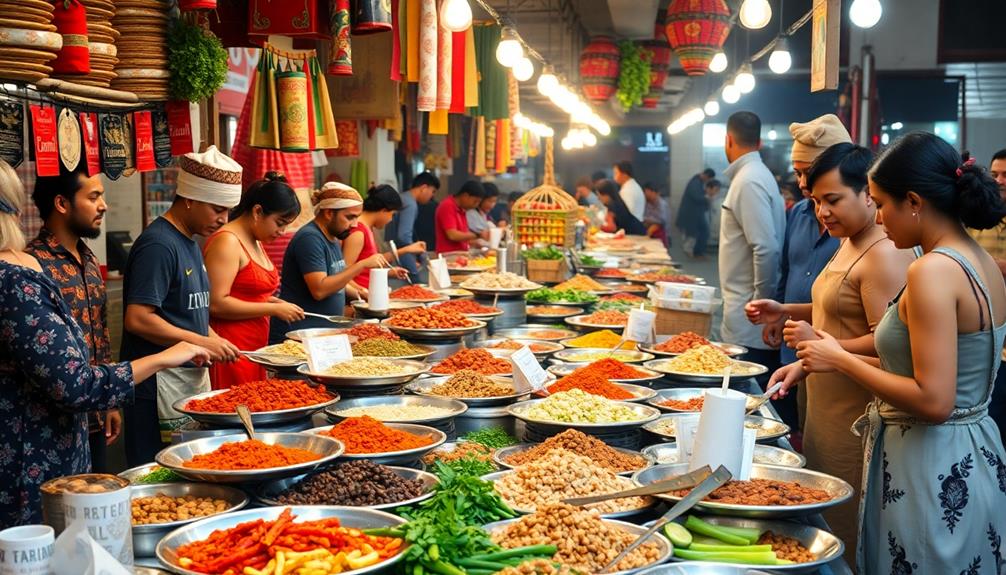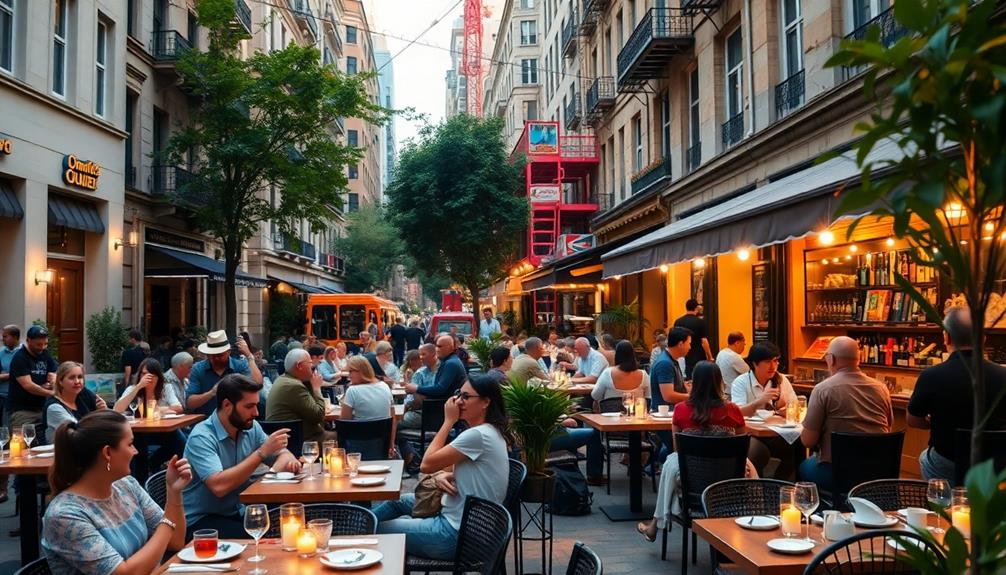Cultural diaspora shapes fusion cuisine by blending diverse culinary techniques and ingredients, creating unique dining experiences. As people migrate, they bring their flavors, enriching local cuisines with new tastes. You might notice dishes like Korean tacos or sushi burritos that reflect this vibrant interplay of cultures. Chefs often experiment with combining traditional recipes and contemporary techniques, appealing to adventurous diners craving innovative flavors. Plus, the rise of food trucks and pop-up restaurants encourages this culinary creativity. If you're curious about how these trends continue to evolve, you'll find even more exciting insights about the future of fusion cuisine.
Key Takeaways
- Cultural diaspora facilitates the introduction of diverse culinary techniques and ingredients, enriching local cuisines through cross-cultural exchanges.
- Immigrants adapt traditional recipes, leading to innovative dishes that reflect blended culinary traditions and local tastes.
- Ethnic restaurants serve as cultural ambassadors, promoting heritage and fostering appreciation for global flavors within host countries.
- Globalization enhances accessibility to international ingredients, encouraging experimentation and creativity in fusion cuisine.
- Sustainability trends drive the use of local ingredients and responsible cooking practices, reflecting environmental awareness in culinary innovations.
Cultural Diffusion Explained
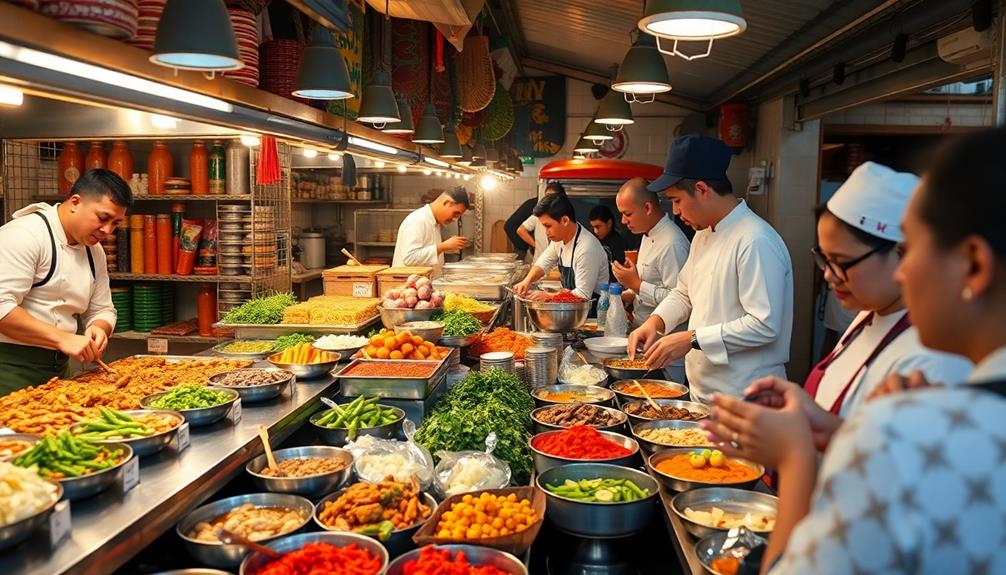
Cultural diffusion plays an essential role in shaping the culinary landscape we enjoy today. This process involves the spread of cultural beliefs and practices, primarily through trade, migration, and conquest, which influences global cuisine.
You might notice how fusion cuisine blends culinary traditions, creating innovative dishes that highlight flavors from different cultures. For instance, Indo-Chinese and Tex-Mex are perfect examples of how diverse culinary practices can merge. Brazilian cuisine also exemplifies this blend, showcasing regional variations that reflect the country's rich cultural tapestry.
Consider the historical spice trade, where spices from India transformed European culinary practices, broadening their flavor profiles. This cultural exchange didn't just stop there; today, you can find creative dishes like the sushi burrito, combining traditional recipes with local ingredients.
This ongoing cultural diffusion continues to shape food culture, allowing you to explore new cooking techniques and diverse flavors.
Fusion Cuisine Evolution
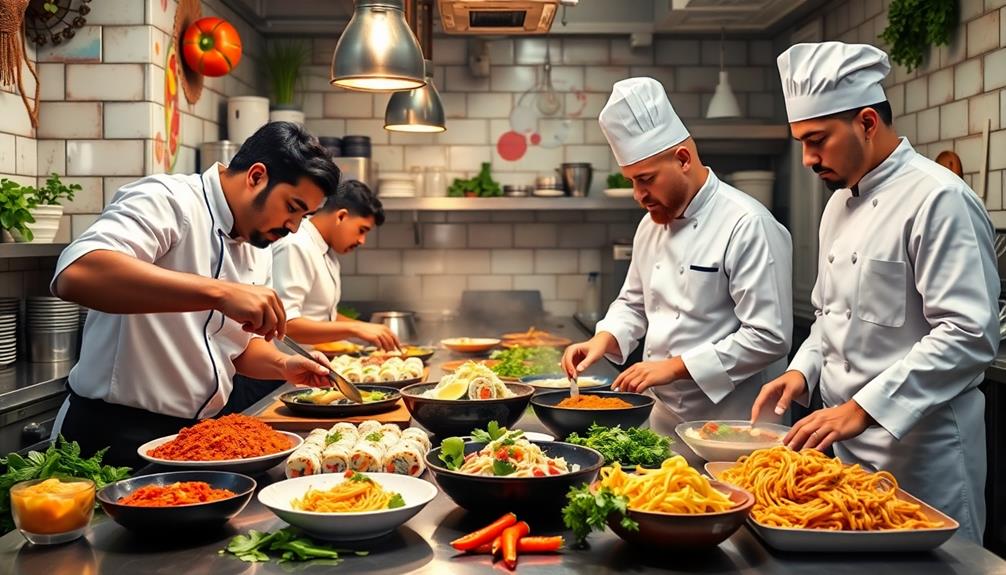
The evolution of fusion cuisine reflects the dynamic interplay of cultures in the culinary world. Since the 1980s, chefs like Wolfgang Puck and Roy Yamaguchi have blended culinary traditions, giving rise to terms like Pan-Asian and Cal-Asian. This cultural diffusion has allowed innovative dishes such as Korean tacos and Japanese-Peruvian ceviche to emerge, showcasing diverse flavor profiles shaped by immigrant populations.
As globalization continues to intertwine food cultures, culinary creativity flourishes. Younger diners are particularly drawn to fusion cuisine, seeking unique dining experiences that challenge conventional boundaries. Food trucks and casual dining spots are at the forefront of this movement, experimenting with daring combinations that reflect a more accepting attitude toward culinary innovation.
Here's a quick look at the key elements driving the evolution of fusion cuisine:
| Aspect | Description |
|---|---|
| Cultural Influences | Blending of diverse culinary traditions |
| Innovative Dishes | Creation of new, hybrid dishes |
| Immigrant Populations | Impact of diverse communities on culinary trends |
| Globalization | Increased accessibility to global ingredients |
| Dining Experiences | Adventurous and unique dining options |
As fusion cuisine evolves, it promises to remain a crucial part of our culinary landscape.
Influences of Migration
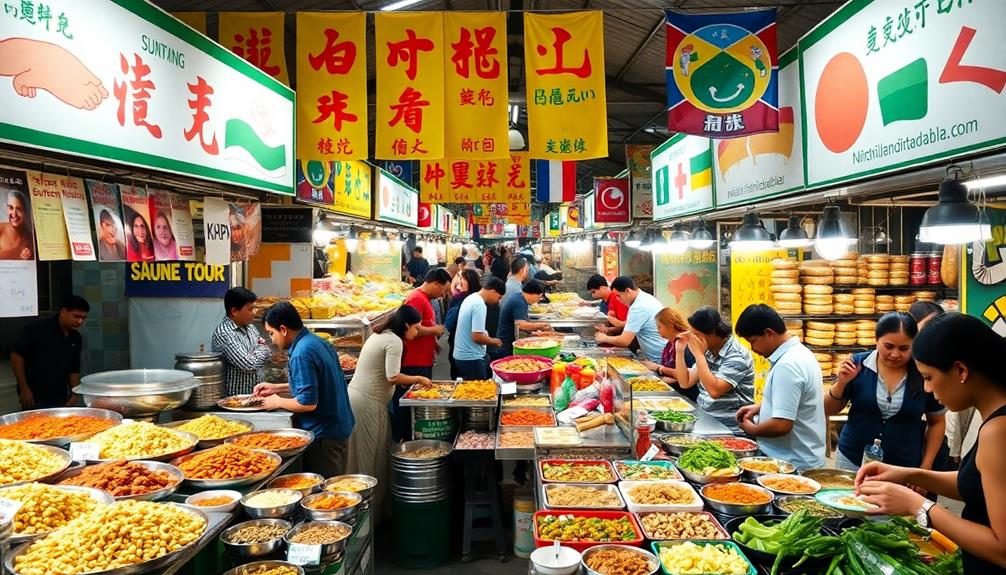
Migration reshapes culinary landscapes by introducing new ingredients and cooking methods to host countries. For instance, traditional Indonesian desserts like Kue Putu and Dadar Gulung reflect the rich flavors that immigrant communities bring to their new homes.
As communities blend, you'll see how culinary traditions evolve, giving rise to exciting fusion cuisine. This transformation often leads to innovative dishes that reflect a mix of cultural heritage.
Here are three key influences of migration on food trends:
- Diverse Ingredients: Immigrants bring local ingredients from their home countries, enriching the culinary scene and inspiring chefs to experiment with flavors.
- Culinary Mashups: Unique combinations like Korean-Mexican tacos or Japanese-Peruvian ceviche showcase how cultural interactions inspire creativity in cooking.
- Ethnic Restaurants as Cultural Ambassadors: These establishments not only serve traditional dishes but also adapt recipes to local tastes, creating a bridge between communities.
Through migration, culinary practices expand, allowing you to savor dishes that celebrate both heritage and innovation.
As you explore these fusion cuisines, you'll discover how migrant communities shape food trends, bringing new life to local dining experiences. The result is a vibrant tapestry of flavors, reflecting the dynamic nature of our ever-evolving global food landscape.
Indian Diaspora Contributions
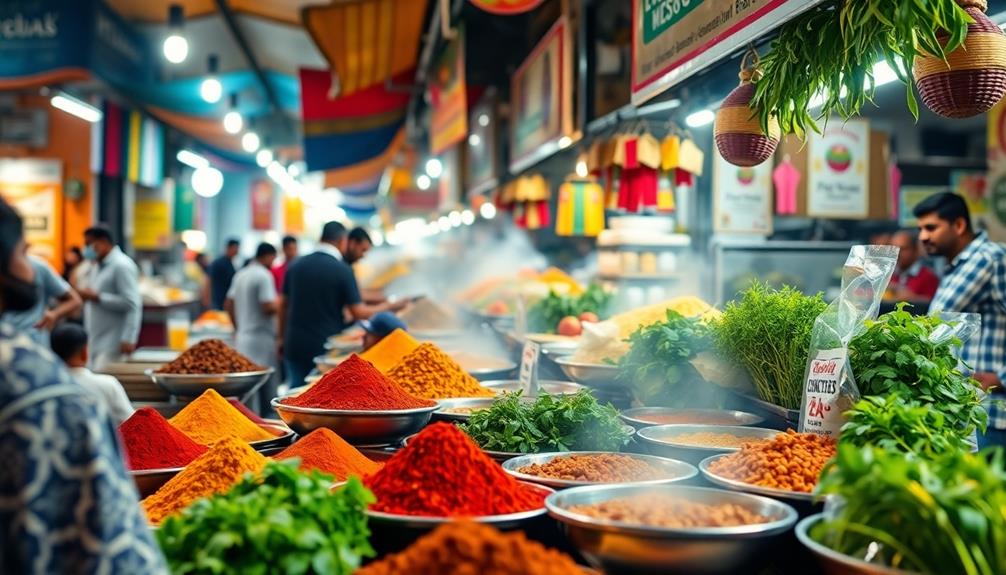
From the bustling streets of London to the vibrant markets of Dubai, the Indian diaspora has made a remarkable impact on global cuisine. By introducing traditional Indian flavors and culinary traditions, it's enriched local cuisines in various countries.
For instance, dishes like Mushroom Masala showcase how earthy flavors can be enhanced through spices, making them appealing to diverse palates. Indian expatriate chefs have led this evolution through cultural exchange, adapting traditional recipes with local ingredients to create innovative dishes like Indian-inspired sushi and curry pasta.
Indian restaurants worldwide act as cultural ambassadors, showcasing the richness of Indian culinary heritage and contributing to local economies. These establishments often feature diverse menus that blend traditional and contemporary Indian dishes, reflecting the global food movement's dynamics.
Events and festivals celebrating Indian cuisine in cities like Dubai further highlight the contributions of the Indian community, bringing together Indian flavors and local culinary practices.
Moreover, the emphasis on vegetarianism within Indian cuisine is gaining traction globally. Chefs are innovating plant-based dishes that honor traditional practices while appealing to contemporary dining trends.
This focus on sustainability not only attracts food enthusiasts but also solidifies the Indian diaspora's role in shaping fusion cuisine across the globe.
Culinary Mash-Ups Today
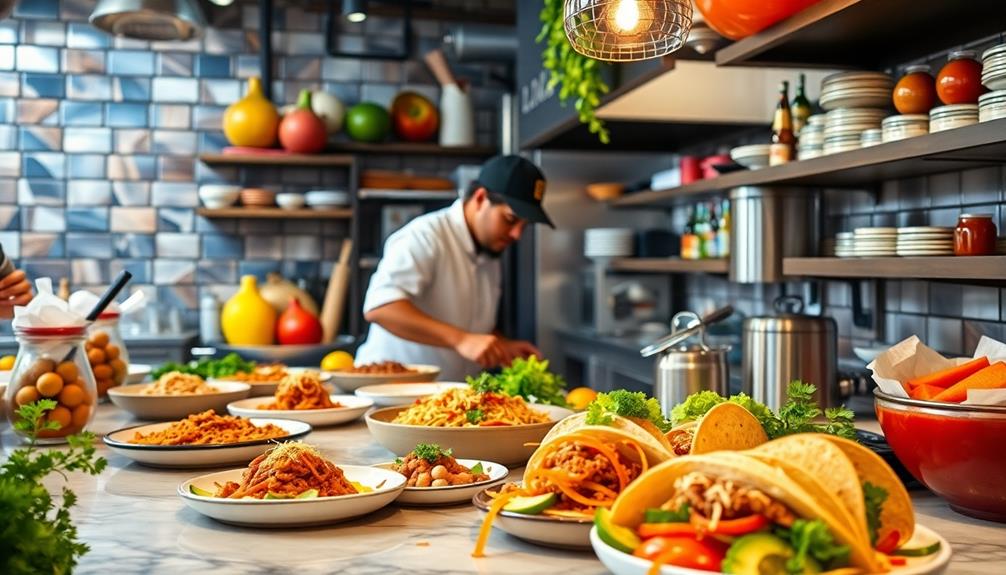
Culinary mash-ups today reflect a broader trend of blending diverse food cultures, taking inspiration from innovations like the Cronut® and ramen burgers.
These creative combinations push the boundaries of traditional cooking styles, offering bold flavors that resonate with adventurous eaters. Food trucks and Quick Service Restaurants (QSRs) are at the forefront, crafting innovative dishes that highlight local ingredients and the cultural significance of various cuisines.
Here are three notable examples of today's culinary mash-ups:
- Korean Tacos: A fusion of Korean BBQ and traditional Mexican tacos, showcasing a blend of spices and textures.
- Sushi Burritos: Wrapping sushi ingredients in a burrito format, this dish combines the best of both worlds, attracting fans of diverse culinary traditions.
- Waffle Tacos: An inventive take on breakfast, merging waffles and tacos for a sweet-savory delight.
Despite concerns about the focus on novelty over quality, these culinary creations continue to thrive, reflecting a sustained consumer interest in fusion food that celebrates a community or region's rich culinary heritage.
Future Trends in Fusion Cuisine
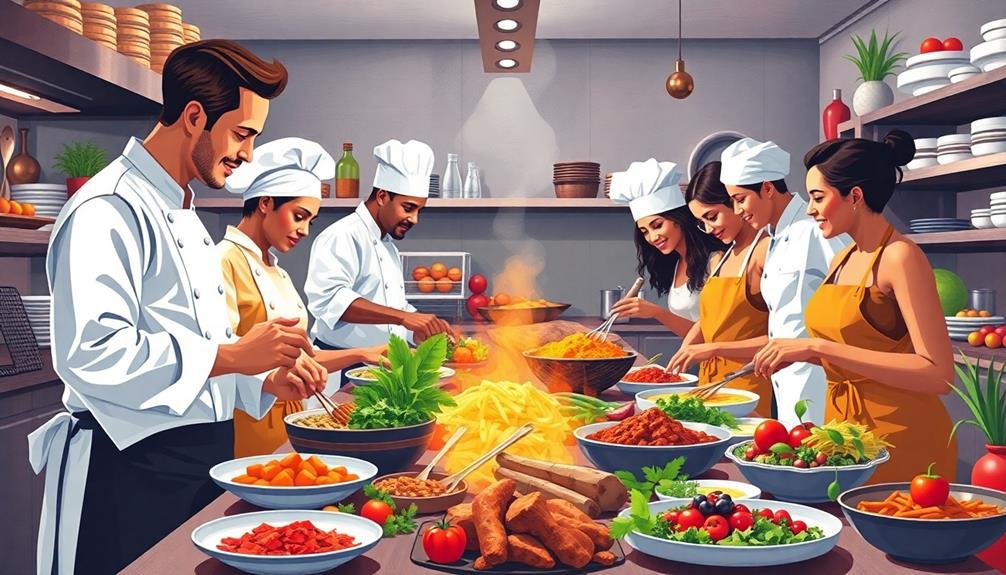
The future of fusion cuisine is bright, driven by a dynamic interplay of globalization and cultural exchange. As migration continues to shape culinary landscapes, you can expect chefs to create innovative fusion dishes that blend traditional culinary techniques with local ingredients.
This evolution caters to diverse palates and embraces the rise of third-culture cuisine, where dining experiences celebrate various culinary heritages.
You'll notice adventurous flavors gaining traction, with dishes like Korean-Mexican tacos and Japanese-Peruvian ceviche becoming mainstream favorites, especially among younger audiences.
Social media and food influencers play an essential role in promoting these trends, as restaurants use technology to create buzz and engage customers in unique dining experiences.
Sustainability will also shape the future of fusion cuisine, as chefs increasingly advocate for environmentally responsible cooking practices.
They'll focus on sourcing local ingredients while exploring global flavors, ensuring that their fusion dishes not only tantalize taste buds but also respect the planet.
As these trends unfold, expect a vibrant culinary landscape that reflects the rich tapestry of our interconnected world, inviting you to explore and indulge in a diverse array of flavors and experiences.
Frequently Asked Questions
What Are the Cultural Roots to Fusion Cuisine?
Fusion cuisine's cultural roots lie in centuries of trade and migration. You'll find diverse culinary practices blending together, creating innovative dishes as immigrant populations introduce their traditional flavors, reflecting a rich tapestry of shared culinary heritage.
Why Has Fusion Cuisine Become so Popular?
Fusion cuisine's like a vibrant tapestry, weaving together flavors from around the world. You've embraced this culinary trend due to globalization, adventurous palates, and social media showcasing unique dishes that tantalize and excite your taste buds.
What Is Cultural Fusion in the Field of Food?
Cultural fusion in food means blending culinary traditions from different backgrounds, creating innovative dishes that highlight unique flavors. You'll often find exciting combinations that surprise your palate, reflecting both creativity and multicultural influences in dining.
How Does Culture Influence Food?
Culture influences food by shaping your tastes, cooking methods, and ingredient choices. When you embrace new traditions, you create unique dishes that reflect your experiences, enhancing your culinary journey and connecting you to diverse communities.
Conclusion
As you explore the vibrant world of fusion cuisine, you'll see how cultural diaspora weaves together flavors like a tapestry of stories. Just as spices traveled the Silk Road, today's culinary mash-ups reflect journeys of migration and innovation. Embrace the delicious possibilities ahead, where each bite is a celebration of diversity and creativity. The future of fusion cuisine isn't just on your plate; it's a shared experience that transcends borders and unites us all.
